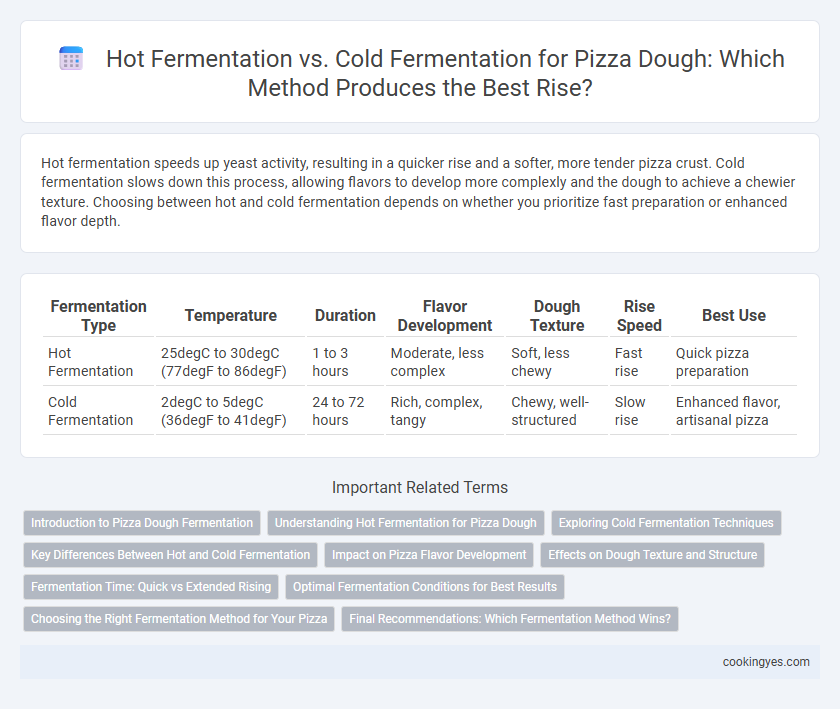Hot fermentation speeds up yeast activity, resulting in a quicker rise and a softer, more tender pizza crust. Cold fermentation slows down this process, allowing flavors to develop more complexly and the dough to achieve a chewier texture. Choosing between hot and cold fermentation depends on whether you prioritize fast preparation or enhanced flavor depth.
Table of Comparison
| Fermentation Type | Temperature | Duration | Flavor Development | Dough Texture | Rise Speed | Best Use |
|---|---|---|---|---|---|---|
| Hot Fermentation | 25degC to 30degC (77degF to 86degF) | 1 to 3 hours | Moderate, less complex | Soft, less chewy | Fast rise | Quick pizza preparation |
| Cold Fermentation | 2degC to 5degC (36degF to 41degF) | 24 to 72 hours | Rich, complex, tangy | Chewy, well-structured | Slow rise | Enhanced flavor, artisanal pizza |
Introduction to Pizza Dough Fermentation
Hot fermentation accelerates yeast activity, producing pizza dough that rises quickly and develops a mildly tangy flavor ideal for same-day baking. Cold fermentation slows yeast metabolism by refrigerating the dough for 24 to 72 hours, enhancing complex flavors and chewy texture through prolonged gas production and enzymatic reactions. Both methods impact gluten development and fermentation byproducts, crucial for achieving desired crust characteristics in Neapolitan and New York-style pizzas.
Understanding Hot Fermentation for Pizza Dough
Hot fermentation accelerates yeast activity by maintaining dough temperatures between 75degF and 85degF, resulting in faster rise times and enhanced gluten development for a chewy texture. This method typically takes 1 to 3 hours and produces a mild, yeasty flavor, ideal for quick pizza preparation without compromising dough quality. Understanding hot fermentation helps pizza makers optimize dough elasticity and gas retention, crucial for achieving a light, airy crust.
Exploring Cold Fermentation Techniques
Cold fermentation for pizza involves fermenting the dough at low temperatures, typically between 39degF and 45degF (4degC to 7degC), over 24 to 72 hours, which enhances the dough's flavor and texture. This slow fermentation process allows yeast to produce complex organic acids and gas more gradually, resulting in a chewier crust with increased depth of taste and improved digestibility. Techniques such as selecting strong flour with high protein content and maintaining precise temperature control during refrigeration are critical for optimizing cold fermentation outcomes in artisan pizza-making.
Key Differences Between Hot and Cold Fermentation
Hot fermentation accelerates yeast activity by maintaining dough temperatures between 75-85degF, resulting in faster rise times of 1-3 hours and a softer crust texture. Cold fermentation slows yeast fermentation at temperatures of 38-50degF, extending the rise to 24-72 hours, enhancing flavor complexity and producing a chewier, more developed crust structure. The key differences lie in fermentation duration, temperature control, and the impact on dough flavor and texture, with hot fermentation prioritizing speed and cold fermentation emphasizing taste and dough development.
Impact on Pizza Flavor Development
Hot fermentation accelerates yeast activity, producing a faster rise with a lighter, more yeasty flavor but less complex taste. Cold fermentation slows down yeast metabolism, allowing longer fermentation that enhances enzymatic breakdown and develops deeper, more nuanced flavors with improved dough texture. The prolonged cold fermentation process results in a richer aroma and subtle sourdough notes, making it preferred for artisan-style pizzas.
Effects on Dough Texture and Structure
Hot fermentation accelerates yeast activity, producing a softer dough with a more open crumb and a slightly tangy flavor due to faster gas production. Cold fermentation slows yeast metabolism, allowing enzymes to break down starches and proteins more thoroughly, resulting in a chewier texture and complex flavor development. The extended cold fermentation enhances gluten strength and dough extensibility, contributing to a well-structured crust with an improved rise and better oven spring.
Fermentation Time: Quick vs Extended Rising
Hot fermentation accelerates yeast activity, resulting in a quick rising process typically completed within 1 to 3 hours, which produces a lighter crust but less complex flavor. Cold fermentation involves refrigerating the dough for 24 to 72 hours, allowing slower yeast fermentation that develops deeper taste profiles and improved dough texture. Extended rising in cold fermentation enhances gluten structure and creates a more flavorful, chewy pizza crust compared to the rapid rise of hot fermentation.
Optimal Fermentation Conditions for Best Results
Hot fermentation accelerates yeast activity by maintaining dough temperatures between 75degF and 85degF, resulting in quicker rise times but potentially less flavor development. Cold fermentation, typically done at 38degF to 45degF over 24 to 72 hours, slows yeast metabolism, enhancing complex flavor profiles and dough texture through gradual gluten development. Optimizing fermentation requires balancing temperature and time to achieve desired crust elasticity and depth of taste, with cold fermentation favored for traditional Neapolitan-style pizzas and hot fermentation suited for rapid preparation.
Choosing the Right Fermentation Method for Your Pizza
Hot fermentation accelerates yeast activity, producing a quicker rise and a softer, airier pizza crust, ideal for same-day baking. Cold fermentation slows down the yeast, enhancing flavor complexity and dough texture over 24 to 72 hours, perfect for achieving a more developed, chewy crust. Selecting between hot and cold fermentation depends on your desired dough flavor, texture, and preparation time, with cold fermentation favored by artisan pizza makers aiming for rich taste and hot fermentation suited for fast turnaround.
Final Recommendations: Which Fermentation Method Wins?
Cold fermentation offers a superior flavor profile and better dough texture by allowing enzymes to break down starches slowly over 24 to 72 hours, resulting in a more complex, airy crust with enhanced chewiness. Hot fermentation shortens rising time to 1-3 hours but can lead to less flavorful and denser dough due to rapid yeast activity. For artisanal pizza aiming at maximum taste and ideal crumb structure, cold fermentation is the recommended method.
Hot fermentation vs Cold fermentation for pizza rise Infographic

 cookingyes.com
cookingyes.com